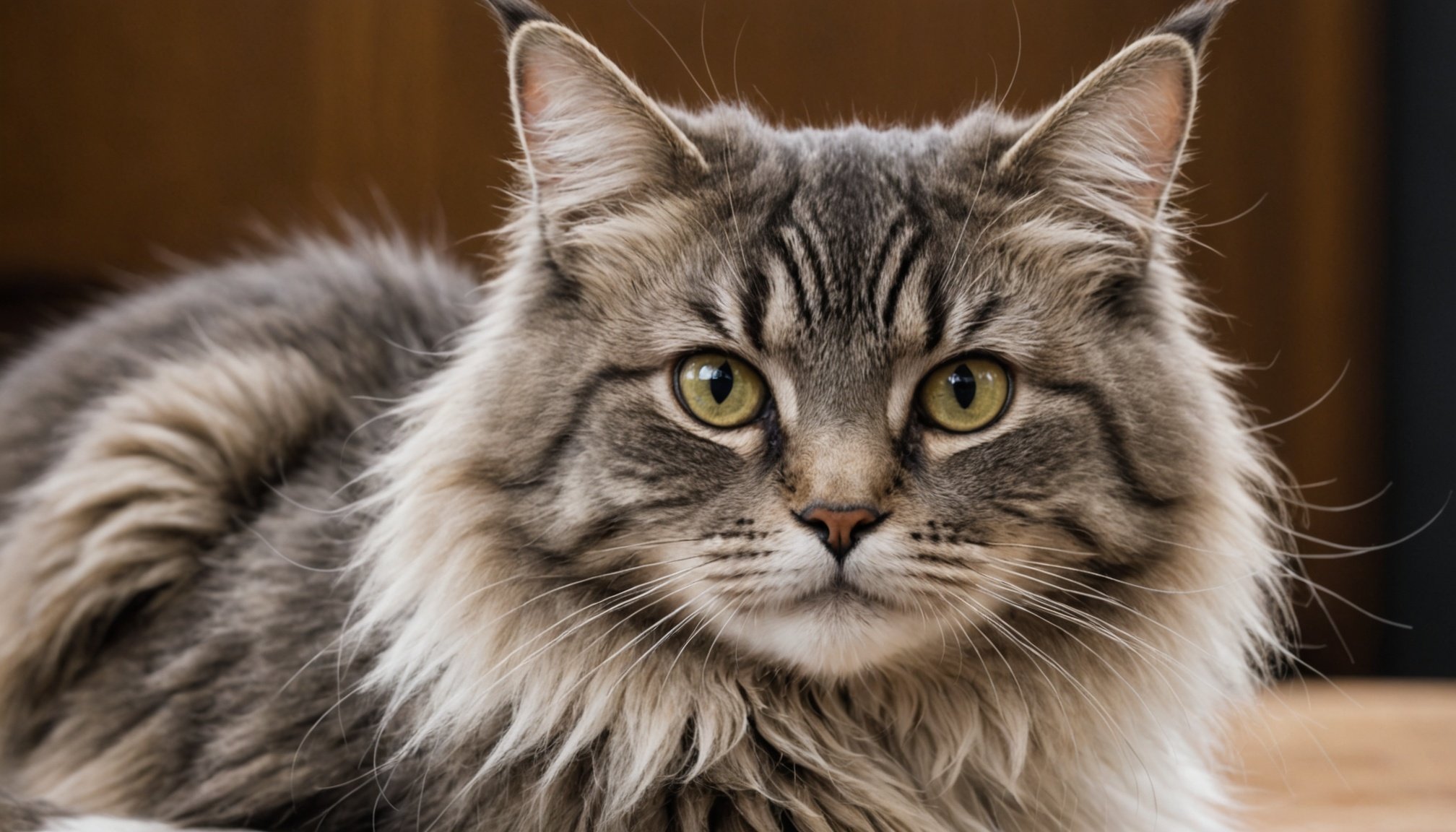Ultimate Guide to Preventing and Managing Fur Matting in Long-Haired Cats: Tips and Tricks for Happy Grooming
Understanding the Issue of Fur Matting in Long-Haired Cats
Fur matting is a common problem that many long-haired cat owners face. It can be painful for the cat, lead to skin irritation, and even cause infections if not addressed properly. To understand why matting occurs, it’s essential to look at the natural attributes of a long-haired cat’s coat.
Long-haired cats have a double coat: an undercoat and a topcoat. The undercoat is soft and dense, while the topcoat is longer and coarser. When these two layers intertwine, they can form mats and tangles, especially in areas where the cat rubs against surfaces or where the fur is longest, such as the armpits, behind the ears, and around the base of the tail.
Also to discover : The complete handbook for seamlessly integrating your rescue parrot with other birds
The Importance of Regular Grooming
Regular grooming is the cornerstone of preventing and managing fur matting in long-haired cats. Here are some key reasons why grooming should be a part of your daily routine:
Reduces Matting and Tangling
Regular brushing helps to remove loose hair and prevent mats from forming. It also distributes natural oils throughout the coat, keeping it healthy and shiny.
Also to read : Custom fitness regimens for pomeranians with luxating patella: enhancing health and mobility for your furry friend
Improves Skin Health
Grooming allows you to inspect your cat’s skin regularly, helping you identify any signs of irritation or infection early on.
Enhances Bonding
Grooming sessions can be a great way to bond with your cat, making them feel comfortable and relaxed.
Helps in Early Detection of Health Issues
During grooming, you can check for any unusual lumps, bumps, or changes in your cat’s skin or coat that might indicate a health issue.
Essential Grooming Tools for Long-Haired Cats
To effectively groom your long-haired cat, you’ll need the right tools. Here are some essentials:
- Slicker Brush: This brush is designed to remove tangles and mats from the coat. It has fine teeth that are close together, making it perfect for long-haired cats.
- Pin Brush: Similar to a human hairbrush, this brush has long, thin bristles that are gentle on the cat’s coat and help in smoothing out the fur.
- Mat Breaker: This tool is specifically designed to gently tease out mats without causing pain or discomfort to the cat.
- Nail Trimmers: Keeping your cat’s nails trimmed is crucial to prevent them from getting caught in the fur and causing mats.
- Shedding Rake: This tool helps in removing loose hair, especially during shedding season.
Step-by-Step Guide to Grooming Your Long-Haired Cat
Grooming a long-haired cat requires patience and the right technique. Here’s a step-by-step guide to help you through the process:
Prepare Your Cat
- Start by making your cat comfortable with the grooming process. Begin with short sessions and gradually increase the time.
- Choose a quiet, distraction-free area where your cat feels safe.
Brush the Coat
- Begin with a slicker brush or a pin brush to gently work through the coat, starting from the head and moving down to the tail.
- Be gentle around sensitive areas like the armpits and behind the ears.
Remove Mats and Tangles
- If you encounter mats or tangles, use a mat breaker to gently tease them out. Avoid using scissors as they can be dangerous and cause injury.
- Work slowly and patiently, as mats can be painful for the cat.
Trim Nails
- Use nail trimmers to keep your cat’s nails short. Long nails can get caught in the fur and cause matting.
Check for Skin Issues
- During grooming, inspect your cat’s skin for any signs of irritation, redness, or infection.
Tips for Managing Matted Fur
Managing matted fur can be challenging, but here are some tips to help you:
Use the Right Tools
- Invest in a good quality mat breaker or a detangling spray to help make the process easier.
- A self-cleaning spray brush, like the L&W BROS. 2-in-1 Auto-Nettoyage Spray Cat Brush, can be very effective in removing static hair and preventing matting[5].
Be Patient
- Removing mats and tangles can be time-consuming and painful for the cat. Be patient and work slowly.
Consider Professional Help
- If the mats are severe or your cat is particularly sensitive, consider taking them to a professional groomer.
Home Care and Additional Tips
In addition to regular grooming, here are some home care tips to help prevent and manage fur matting:
Keep Your Home Clean
- Regularly vacuum your home to reduce the amount of loose hair that can contribute to matting.
- Use a dissolvant de poils d’animaux (animal hair dissolver) to clean surfaces and furniture[4].
Bathe Your Cat Occasionally
- While long-haired cats don’t need frequent bathing, an occasional bath can help in removing dirt and oils that can contribute to matting.
- Use a gentle shampoo specifically designed for cats.
Provide a Balanced Diet
- A balanced diet rich in omega-3 fatty acids can help keep your cat’s coat healthy and reduce shedding.
Table: Comparing Grooming Tools for Long-Haired Cats
| Tool | Description | Benefits | Drawbacks |
|---|---|---|---|
| Slicker Brush | Fine teeth close together to remove tangles and mats. | Effective in removing mats and tangles, distributes natural oils. | Can be painful if used roughly. |
| Pin Brush | Long, thin bristles for smoothing the fur. | Gentle on the coat, helps in smoothing out the fur. | Not as effective for removing mats. |
| Mat Breaker | Designed to gently tease out mats. | Safe and effective for removing mats without causing pain. | Requires patience and skill to use correctly. |
| Nail Trimmers | For trimming the cat’s nails. | Prevents nails from getting caught in the fur and causing mats. | Requires caution to avoid cutting the quick. |
| Shedding Rake | Removes loose hair, especially during shedding season. | Reduces shedding and prevents matting. | Can be rough on the skin if used aggressively. |
Quotes from Experts and Cat Owners
- “Regular grooming is not just about keeping your cat’s coat looking good; it’s also about maintaining their overall health and well-being.” – Dr. Jane Smith, Veterinarian
- “I was amazed at how much of a difference regular grooming made for my long-haired cat. The mats almost disappeared, and her coat looked healthier than ever.” – Sarah Johnson, Cat Owner
- “Using the right tools is crucial. A good slicker brush and a mat breaker can make all the difference in managing matted fur.” – John Doe, Professional Groomer
Preventing and managing fur matting in long-haired cats requires a combination of regular grooming, the right tools, and a bit of patience. By understanding the natural attributes of your cat’s coat, using the right grooming tools, and following the tips outlined in this guide, you can help keep your cat’s coat healthy, shiny, and mat-free.
Remember, grooming is not just about the physical health of your cat; it also strengthens the bond between you and your feline friend. So, take the time to brush, inspect, and care for your cat’s coat, and you’ll be rewarded with a happy, healthy, and beautifully groomed long-haired cat.











